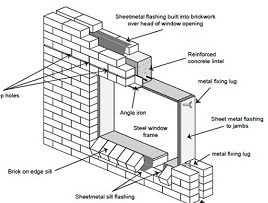Repairing Broken Window Glass
 Broken panes of glass are easier to repair in some types of window frame than others but most can be attempted. Replacing a single glass pane is achievable by most home renovators.
Broken panes of glass are easier to repair in some types of window frame than others but most can be attempted. Replacing a single glass pane is achievable by most home renovators.
Before attempting to remove broken glass make sure you have suitable strong work gloves, gauntlet types preferably. Also protective eyewear and overalls are wise. Have some newspaper or packaging paper laid out into which to place your glass pieces.
Remove the broken shards form the frame by gently manipulating them from side to side. Be very careful how you handle it since sharp edges will penetrate gloves if not held flat. Also, be wary that sometimes shards will dislodge and spring out. If it snaps some glass may fly through the air. You can try attaching packing tape to the surface before breaking glass so as to hold it together.
When you free the glass, place it onto the newspaper. When it's all out, fold the paper lightly around it and place in a cardboard box or heavy duty bag e.g. empty sand bag. Dispose of carefully.
To order replacement glass, measure the frame exactly and deduct a couple of millimetres from the length and width.
For wooden windows:
After removing the glass you'll need to scrape out the old putty. You can do this with a putty knife or paint scraper. A blowtorch can be used to make the putty more pliable if there's a risk of damaging the frame. If you need to remove beading around where the glass sits this is usually nailed into place with panel pins. Try sliding the tip of an old chisel underneath the beading to raise it. You may need to use a piece of wood beneath the shaft of the chisel to add leverage. Once you are able to a claw hammer or crowbar can be used to prize the beading free.
To remove nails which were holding the glass panel in position these are easy to pull out with pliers or grips. Once removed the frame can be lightly sanded to smooth the surface and then coated with a linseed oil which stops the new putty form drying out too quickly.
Use you putty knife to apply a small amount of putty to the frame. Then insert the new glass panel and press against the putty. Use pins to hold the pane in place nailed in every 10 to 12cm. These should be deep enough that the putty will cover them and shallow enough that they hold the glass. Then apply putty to the inside, brush it with linseed oil, and bevel it at 45 degrees using the putty knife for a smooth finish.
If the window has beading, use a silicon sealant behind the new pane instead of putty. Put the new pane in place and replace the beading.
For uPVC or aluminium windows:
Remove the spring clips or uPVC splines. You'll need to do this by unscrewing screws with a screwdriver or pulling out with pliers. With aluminium frames often the whole window assembly needs to be removed from the frame which is secured to the wall opening by undoing screws holding it in place.
For sliding windows these can be lifted up and out of the assembly once it is removed. Hinged windows will need to be unscrewed. One the window is free of the assembly its frame can be unscrewed. Inside there is a rubber gasket which holds the glass. This cans be lifted out and fragments of glass removed by wiping with a damp cloth. It also gives you an opportunity to remove any grime or dust which has accumulated. This rubber gasket should then be placed around the new pane of glass and the pane is inserted into the frame. Reassemble by screwing back together. You don't need to use silicon or other sealants since the rubber forms a perfect seal.
NEW COURSE LAUNCHED NOVEMBER 2017
Learn to Renovate a Room or entire Building with our Building Reno Course Click here